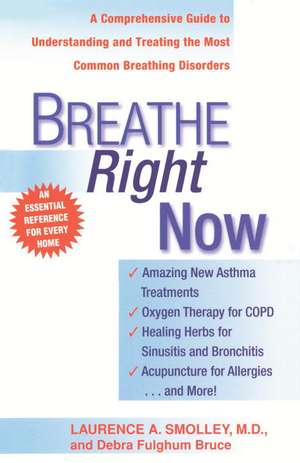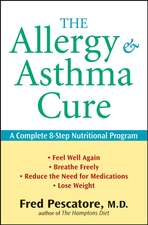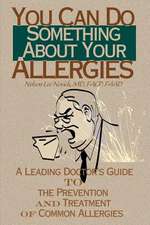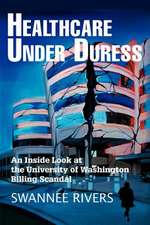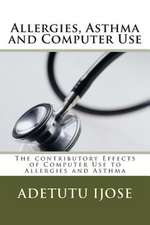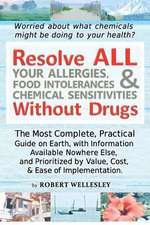Breathe Right Now
Autor Laurence A. Smolleyen Limba Engleză Paperback – 31 iul 1998
Amazing New Asthma Treatments
Oxygen Therapy for COPD
Healing Herbs for Sinusitis and Bronchitis
Acupuncture for Allergies
Medications to prevent nearly 100% of asthma attacks
Filters to chase away hay fever
Therapies to dramatically improve emphysema
Inhalers to end chronic bronchitis
New breakthroughs in the treatment of cystic fibrosis . . . . and more!
From the Paperback edition.
Preț: 116.55 lei
Nou
Puncte Express: 175
Preț estimativ în valută:
22.30€ • 23.20$ • 18.41£
22.30€ • 23.20$ • 18.41£
Carte disponibilă
Livrare economică 24 martie-07 aprilie
Preluare comenzi: 021 569.72.76
Specificații
ISBN-13: 9780440613848
ISBN-10: 0440613841
Pagini: 356
Dimensiuni: 140 x 216 x 20 mm
Greutate: 0.45 kg
Editura: Dell Publishing Company
ISBN-10: 0440613841
Pagini: 356
Dimensiuni: 140 x 216 x 20 mm
Greutate: 0.45 kg
Editura: Dell Publishing Company
Notă biografică
Laurence A. Smolley, M.D., is a pulmonologist with the Cleveland Clinic Florida in Fort Lauderdale, Florida.
Debra Fulghum Bruce is former editor in chief of Living Well Today and the author or coauthor of forty books, including most recently Super Aspirin Cure for Arthritis. She lives in Orlando, Florida.
From the Paperback edition.
Debra Fulghum Bruce is former editor in chief of Living Well Today and the author or coauthor of forty books, including most recently Super Aspirin Cure for Arthritis. She lives in Orlando, Florida.
From the Paperback edition.
Extras
Introduction: New Hope for Better Breathing
Everyone has experienced breathing difficulties from time to time. For some people, these symptoms subside, and they can move on with their lives. But for millions who suffer daily with breathing disorders, such debilitating symptoms as coughing, sneezing, stuffy nose, breathlessness, and wheezing are relentless and cause poor quality of life. Many claim that breathing problems have ruined much of their lives. You deserve to know that with today's treatment options; it does not have to be that way.
Perhaps you are thinking, "This book will not help me. My nose is constantly congested and just thinking about exercise causes shortness of breath." Well, we have good news! We have experienced all types of respiratory disorders, both professionally and personally. As a pulmonologist and sleep disorders specialist, Dr. Smolley's professional experience in treating respiratory diseases for the past sixteen years keeps him acutely aware of breakthroughs in diagnosis and treatment. Debra Fulghum Bruce has a strong genetic link in her family to allergy, sinusitis, asthma, and chronic obstructive pulmonary disease (COPD), with every member in her immediate and extended family suffering from some type of respiratory symptom daily. It is her personal challenge to find answers to help those closest to her.
Dr. Laurence Smolley
In medical school and during my internship-residency training, I enjoyed learning about all the various specialties of medicine. I particularly treasured the time spent in the "Chest" building at the Kings County Hospital in Brooklyn, New York, where I helped care for patients with the whole gamut of respiratory diseases. My supervising physicians were excellent role models, and I admired them very much.
However, the reason that I chose to apply for a fellowship in pulmonary diseases was because of a tragic personal experience. One summer when I was home from college, my father died right before my eyes during a sudden attack of shortness of breath. Clumsy resuscitative attempts did not work, and the paramedics from 911 in New York City arrived far too late. I know my father died an early death at age fifty-nine, because he ignored the warning signs and symptoms of disease. Perhaps if he knew more and sought treatment earlier, he would still be alive today.
The symptom of shortness of breath, along with a host of other breathing difficulties, has intrigued me over the years. Figuring out the exact cause of the problem is essential before proper treatment can be applied. My experience dealing with patients with respiratory diseases has shown me that those who are best informed and take an active role in their medical care generally have fewer hospitalizations and longer lifespans.
I know that the treatment choices in this book really do work. These options have helped thousands of sufferers across the country regain the ability to breathe clearly, and, thus, improve quality of life.
Debra Fulghum Bruce
My experience with respiratory diseases is very personal and serves as motivation for writing this book. As a child, I grew up thinking that nasal congestion, sinus drainage, and coughing on arising or during exercise were normal. After all, no one in my family could breathe well, suffering as they did from both allergy and asthma, so these symptoms were all I knew. Even as young as five years old, I was given a cup of strong coffee on awakening to help open clogged airways. On school days, my mother would warn, "Don't run at recess if you have trouble breathing."
Although I was oblivious to our family history, I vaguely remember my parents talking about my paternal grandfather who had bronchiectasis, an older cousin who died of complications of asthma, an aunt who suffered with emphysema, and several relatives on my mother's side who had constant headaches from chronic sinusitis. When I got a cold and had to stay home because of "funny whistles in my chest (bronchial asthma)," again, I figured this was "normal." You will learn in this book that these symptoms are not "normal," and there is treatment!
After I was married (to a man who had childhood asthma) and our third child, Ashley, was born, I was forced to begin a personal quest for answers to better breathing. Ashley had fluid in her ears the first year of life, along with a host of skin allergies. During the preschool years, she began to have frequent bouts of bronchitis and sinusitis. At age seven, after a lengthy bout of the flu and bronchitis, Ashley went through allergy testing and was diagnosed with many allergies and chronic asthma. She was not alone: our older children, Rob and Brittnye, were also diagnosed with allergies and asthma and suffered daily from symptoms of nasal congestion, coughing, or wheezing.
It was at a family reunion that I realized someone had to take immediate action to find relief for our strong genetic predisposition to breathing problems. While sitting with a group of relatives, I will never forget how several aunts, uncles, and cousins took puffs from asthma inhalers to open swollen airways. Conversation centered on who had tried the latest nonsedating antihistamines or who had found relief for sinus pain and pressure. Later that evening, I felt hopeless as I surveyed our family's medicine closet. It was filled with inhaler boxes and canisters, bottles of over-the-counter decongestants and antihistamines, prescription antibiotics, and steroid nasal sprays, to mention just a few.
Today, I know there is hope. Through regular visits with our allergist, talking with many health care professionals across the country, and doing years of research, I have realized that everyone deserves the opportunity to breathe right now. No matter what respiratory problems you face, we will show you a wealth of available treatments that will allow you to have the highest quality of life, including exercise. And the best way to better breathing is to educate yourself about the problem, then work as a team with your physician and your family using the proactive steps as outlined in this book.
We've Found the Answers
We wrote this book to offer new hope to those who wake up each day struggling for breath and are frustrated through the day when breathlessness occurs with minimal exertion. Throughout this book, you will learn how some of the country's finest health care professionals treat breathing disorders with both conventional medicine and complementary methods such as biofeedback or acupuncture. You will find accurate descriptions and explanations of the most common breathing problems and learn the latest, most effective methods for diagnosis, treatment, and prevention.
Because almost everyone who suffers from one breathing problem is likely to have others, we have written the first book that covers most common breathing disorders. For example, you may suffer with allergy and asthma and then develop emphysema or chronic bronchitis from smoking. To breathe optimally, you must recognize the specific diseases and promptly seek prevention and treatment measures that are likely to be effective.
As you identify your particular problem, it is important to realize that you are not alone. An estimated 60 million people in the United States today have allergy and asthma. Another 20 million suffer with chronic lung disease. These problems are very common and know no barriers of race, sex, or age. Allergy and asthma alone account for one out of nine trips to the doctor; children also figure high in this number as breathing problems account for more than one out of every five trips to the pediatrician.
Breathing problems are nothing new to millions. However, most people remain unaware of how these diseases which cause shortness of breath, chronic cough, wheezing, and difficulty performing the activities of daily living can be controlled. Must those with breathing disorders simply accept the feeling of choking or strangling? Should they tolerate the limited mobility, inability to exercise, or sleepless nights that often accompany nocturnal breathlessness? The answer is no!
Allergic Triggers
Some believe that it is only children, the elderly, or smokers who suffer breathing problems, but that is not true. Breathing problems can begin in the first year of life. Or, some people can be disease-free until retirement age and then be faced with shortness of breath from COPD, or adult-onset asthma. Allergies can come and go. This means you may be allergic to a certain food such as peanuts, soy, or eggs as a young child and then during your teen years develop an allergy to pollen, mold, or that favorite down comforter.
Some triggers of allergy and asthma include pregnancy (from hormonal and blood-flow changes), viral infection such as cold or flu, exposure to something in the environment, and food. Food allergies can be fatal. A recent report from the National Institutes of Health (NIH) estimates that more than 1 million people a year suffer from a life-threatening anaphylactic reaction to food. Anaphylaxis is the most severe form of allergy and involves the entire body. When it occurs, the blood pressure plunges to dangerously low levels. There is also swelling throughout the body. When this occurs in the walls of the bronchial tubes, there may be a severe obstruction which slows down the exit of air from the lungs. When this occurs in the larynx or upper airway, air may not be able to enter the lungs.
More recently, scientists have found that estrogen levels trigger asthma in some women. Women with asthma may experience a worsening of symptoms, including increased coughing and wheezing, during the week before menstruation. These new findings were reported at the 1996 American College of Clinical Pharmacy by researcher Mary Chandler, an associate professor of pharmacy at the University of Kentucky, who followed fourteen women for three menstrual cycles. These women kept careful records of their asthma symptoms and measured their airflows with peak expiratory flow meters (PEFRs) (more on this indispensable tool for asthma management in Chapter 4).
Determined by symptoms, and also the peak flow rate, all fourteen women in the study experienced at least a 20 percent increase in symptoms during the premenstrual phase. Researchers found that asthma symptoms were mildest on day 13 of the cycle and strongest at day 26, when estrogen is at its lowest level.
Emotions also influence some breathing problems. In fact, it used to be thought that asthma was a psychosomatic disease. Now we know that stress may be a trigger. In other words, if you don't have asthma, emotional stress cannot cause it. However, if you do have asthma, being upset, crying, or getting angry can worsen the symptoms or even bring on an attack.
Predisposition
Although factors such as respiratory infections, air pollution, diet, and emotional makeup play key roles in precipitating problems, your genetic heritage is also important as Debra shared in her personal story. For example, if one parent has allergies, each child has a one-in-three chance of also having allergies. If both parents suffered from allergy, the probability that each child may also suffer is close to 100 percent. Family history also appears to predispose you to asthma and COPD, with three-fifths of all asthma cases being hereditary.
A Holistic Approach
Obviously many risk factors play key roles in breathing disorders, including genetics, diet, illnesses, hormones, environment, and emotional makeup. Because of this crucial mind-body interplay, you deserve to know that taking a holistic, or comprehensive, approach to better breathing can offer even greater benefit. This book will take that approach and explain the importance of:
Understanding risk factors and learning how to reduce your risk
Getting an accurate diagnosis using the latest diagnostic tools
Developing a management plan with your doctor and family
Knowing which medications are best to treat and prevent your particular symptoms
Understanding and avoiding the triggers of your breathing disorder
Exercising to maximize aerobic fitness by conditioning the heart and other muscles
Preventing exercise-induced breathing problems
Reducing stress
Eating nutritional foods to maximize immune defenses against infections
Using healing foods filled with phytochemicals, antioxidants, and flavonoids
Maintaining a normal weight
Obtaining restful sleep, even with nocturnal breathing problems
A Comprehensive Guide
No matter what problem you have, the goal should be to reach the stage at which the disorder can be controlled. Once this is accomplished, returning to normal activity and exercise is possible. There will be improved sleep and a greater sense of well-being. Although we outline a broad spectrum of treatments throughout the book, we continually emphasize the importance of preventive measures to avoid acute attacks and control chronic problems.
While this book is not meant to be an exhaustive medical reference on respiratory diseases, it is a comprehensive guide book to help you breathe better. To gain further insight about your particular problem, call the support groups listed and check the web sites offered on the Internet. If you have any questions about your breathing disorder, we encourage you to write these down and ask your health care professional.
In short, the main ingredient in the treatment and prevention of breathing disorders is you--if you begin a comprehensive program to eliminate risk factors, boost your immune power, and stay healthy despite your chronic condition. In other words, you can change things in your life so that the chances of your problems worsening are greatly reduced. You can begin to live your life again and move from patient to person--to happier times at home and improved quality times at work and play--without the constant fear of shortness of breath.
Let's get started.
From the Paperback edition.
Everyone has experienced breathing difficulties from time to time. For some people, these symptoms subside, and they can move on with their lives. But for millions who suffer daily with breathing disorders, such debilitating symptoms as coughing, sneezing, stuffy nose, breathlessness, and wheezing are relentless and cause poor quality of life. Many claim that breathing problems have ruined much of their lives. You deserve to know that with today's treatment options; it does not have to be that way.
Perhaps you are thinking, "This book will not help me. My nose is constantly congested and just thinking about exercise causes shortness of breath." Well, we have good news! We have experienced all types of respiratory disorders, both professionally and personally. As a pulmonologist and sleep disorders specialist, Dr. Smolley's professional experience in treating respiratory diseases for the past sixteen years keeps him acutely aware of breakthroughs in diagnosis and treatment. Debra Fulghum Bruce has a strong genetic link in her family to allergy, sinusitis, asthma, and chronic obstructive pulmonary disease (COPD), with every member in her immediate and extended family suffering from some type of respiratory symptom daily. It is her personal challenge to find answers to help those closest to her.
Dr. Laurence Smolley
In medical school and during my internship-residency training, I enjoyed learning about all the various specialties of medicine. I particularly treasured the time spent in the "Chest" building at the Kings County Hospital in Brooklyn, New York, where I helped care for patients with the whole gamut of respiratory diseases. My supervising physicians were excellent role models, and I admired them very much.
However, the reason that I chose to apply for a fellowship in pulmonary diseases was because of a tragic personal experience. One summer when I was home from college, my father died right before my eyes during a sudden attack of shortness of breath. Clumsy resuscitative attempts did not work, and the paramedics from 911 in New York City arrived far too late. I know my father died an early death at age fifty-nine, because he ignored the warning signs and symptoms of disease. Perhaps if he knew more and sought treatment earlier, he would still be alive today.
The symptom of shortness of breath, along with a host of other breathing difficulties, has intrigued me over the years. Figuring out the exact cause of the problem is essential before proper treatment can be applied. My experience dealing with patients with respiratory diseases has shown me that those who are best informed and take an active role in their medical care generally have fewer hospitalizations and longer lifespans.
I know that the treatment choices in this book really do work. These options have helped thousands of sufferers across the country regain the ability to breathe clearly, and, thus, improve quality of life.
Debra Fulghum Bruce
My experience with respiratory diseases is very personal and serves as motivation for writing this book. As a child, I grew up thinking that nasal congestion, sinus drainage, and coughing on arising or during exercise were normal. After all, no one in my family could breathe well, suffering as they did from both allergy and asthma, so these symptoms were all I knew. Even as young as five years old, I was given a cup of strong coffee on awakening to help open clogged airways. On school days, my mother would warn, "Don't run at recess if you have trouble breathing."
Although I was oblivious to our family history, I vaguely remember my parents talking about my paternal grandfather who had bronchiectasis, an older cousin who died of complications of asthma, an aunt who suffered with emphysema, and several relatives on my mother's side who had constant headaches from chronic sinusitis. When I got a cold and had to stay home because of "funny whistles in my chest (bronchial asthma)," again, I figured this was "normal." You will learn in this book that these symptoms are not "normal," and there is treatment!
After I was married (to a man who had childhood asthma) and our third child, Ashley, was born, I was forced to begin a personal quest for answers to better breathing. Ashley had fluid in her ears the first year of life, along with a host of skin allergies. During the preschool years, she began to have frequent bouts of bronchitis and sinusitis. At age seven, after a lengthy bout of the flu and bronchitis, Ashley went through allergy testing and was diagnosed with many allergies and chronic asthma. She was not alone: our older children, Rob and Brittnye, were also diagnosed with allergies and asthma and suffered daily from symptoms of nasal congestion, coughing, or wheezing.
It was at a family reunion that I realized someone had to take immediate action to find relief for our strong genetic predisposition to breathing problems. While sitting with a group of relatives, I will never forget how several aunts, uncles, and cousins took puffs from asthma inhalers to open swollen airways. Conversation centered on who had tried the latest nonsedating antihistamines or who had found relief for sinus pain and pressure. Later that evening, I felt hopeless as I surveyed our family's medicine closet. It was filled with inhaler boxes and canisters, bottles of over-the-counter decongestants and antihistamines, prescription antibiotics, and steroid nasal sprays, to mention just a few.
Today, I know there is hope. Through regular visits with our allergist, talking with many health care professionals across the country, and doing years of research, I have realized that everyone deserves the opportunity to breathe right now. No matter what respiratory problems you face, we will show you a wealth of available treatments that will allow you to have the highest quality of life, including exercise. And the best way to better breathing is to educate yourself about the problem, then work as a team with your physician and your family using the proactive steps as outlined in this book.
We've Found the Answers
We wrote this book to offer new hope to those who wake up each day struggling for breath and are frustrated through the day when breathlessness occurs with minimal exertion. Throughout this book, you will learn how some of the country's finest health care professionals treat breathing disorders with both conventional medicine and complementary methods such as biofeedback or acupuncture. You will find accurate descriptions and explanations of the most common breathing problems and learn the latest, most effective methods for diagnosis, treatment, and prevention.
Because almost everyone who suffers from one breathing problem is likely to have others, we have written the first book that covers most common breathing disorders. For example, you may suffer with allergy and asthma and then develop emphysema or chronic bronchitis from smoking. To breathe optimally, you must recognize the specific diseases and promptly seek prevention and treatment measures that are likely to be effective.
As you identify your particular problem, it is important to realize that you are not alone. An estimated 60 million people in the United States today have allergy and asthma. Another 20 million suffer with chronic lung disease. These problems are very common and know no barriers of race, sex, or age. Allergy and asthma alone account for one out of nine trips to the doctor; children also figure high in this number as breathing problems account for more than one out of every five trips to the pediatrician.
Breathing problems are nothing new to millions. However, most people remain unaware of how these diseases which cause shortness of breath, chronic cough, wheezing, and difficulty performing the activities of daily living can be controlled. Must those with breathing disorders simply accept the feeling of choking or strangling? Should they tolerate the limited mobility, inability to exercise, or sleepless nights that often accompany nocturnal breathlessness? The answer is no!
Allergic Triggers
Some believe that it is only children, the elderly, or smokers who suffer breathing problems, but that is not true. Breathing problems can begin in the first year of life. Or, some people can be disease-free until retirement age and then be faced with shortness of breath from COPD, or adult-onset asthma. Allergies can come and go. This means you may be allergic to a certain food such as peanuts, soy, or eggs as a young child and then during your teen years develop an allergy to pollen, mold, or that favorite down comforter.
Some triggers of allergy and asthma include pregnancy (from hormonal and blood-flow changes), viral infection such as cold or flu, exposure to something in the environment, and food. Food allergies can be fatal. A recent report from the National Institutes of Health (NIH) estimates that more than 1 million people a year suffer from a life-threatening anaphylactic reaction to food. Anaphylaxis is the most severe form of allergy and involves the entire body. When it occurs, the blood pressure plunges to dangerously low levels. There is also swelling throughout the body. When this occurs in the walls of the bronchial tubes, there may be a severe obstruction which slows down the exit of air from the lungs. When this occurs in the larynx or upper airway, air may not be able to enter the lungs.
More recently, scientists have found that estrogen levels trigger asthma in some women. Women with asthma may experience a worsening of symptoms, including increased coughing and wheezing, during the week before menstruation. These new findings were reported at the 1996 American College of Clinical Pharmacy by researcher Mary Chandler, an associate professor of pharmacy at the University of Kentucky, who followed fourteen women for three menstrual cycles. These women kept careful records of their asthma symptoms and measured their airflows with peak expiratory flow meters (PEFRs) (more on this indispensable tool for asthma management in Chapter 4).
Determined by symptoms, and also the peak flow rate, all fourteen women in the study experienced at least a 20 percent increase in symptoms during the premenstrual phase. Researchers found that asthma symptoms were mildest on day 13 of the cycle and strongest at day 26, when estrogen is at its lowest level.
Emotions also influence some breathing problems. In fact, it used to be thought that asthma was a psychosomatic disease. Now we know that stress may be a trigger. In other words, if you don't have asthma, emotional stress cannot cause it. However, if you do have asthma, being upset, crying, or getting angry can worsen the symptoms or even bring on an attack.
Predisposition
Although factors such as respiratory infections, air pollution, diet, and emotional makeup play key roles in precipitating problems, your genetic heritage is also important as Debra shared in her personal story. For example, if one parent has allergies, each child has a one-in-three chance of also having allergies. If both parents suffered from allergy, the probability that each child may also suffer is close to 100 percent. Family history also appears to predispose you to asthma and COPD, with three-fifths of all asthma cases being hereditary.
A Holistic Approach
Obviously many risk factors play key roles in breathing disorders, including genetics, diet, illnesses, hormones, environment, and emotional makeup. Because of this crucial mind-body interplay, you deserve to know that taking a holistic, or comprehensive, approach to better breathing can offer even greater benefit. This book will take that approach and explain the importance of:
Understanding risk factors and learning how to reduce your risk
Getting an accurate diagnosis using the latest diagnostic tools
Developing a management plan with your doctor and family
Knowing which medications are best to treat and prevent your particular symptoms
Understanding and avoiding the triggers of your breathing disorder
Exercising to maximize aerobic fitness by conditioning the heart and other muscles
Preventing exercise-induced breathing problems
Reducing stress
Eating nutritional foods to maximize immune defenses against infections
Using healing foods filled with phytochemicals, antioxidants, and flavonoids
Maintaining a normal weight
Obtaining restful sleep, even with nocturnal breathing problems
A Comprehensive Guide
No matter what problem you have, the goal should be to reach the stage at which the disorder can be controlled. Once this is accomplished, returning to normal activity and exercise is possible. There will be improved sleep and a greater sense of well-being. Although we outline a broad spectrum of treatments throughout the book, we continually emphasize the importance of preventive measures to avoid acute attacks and control chronic problems.
While this book is not meant to be an exhaustive medical reference on respiratory diseases, it is a comprehensive guide book to help you breathe better. To gain further insight about your particular problem, call the support groups listed and check the web sites offered on the Internet. If you have any questions about your breathing disorder, we encourage you to write these down and ask your health care professional.
In short, the main ingredient in the treatment and prevention of breathing disorders is you--if you begin a comprehensive program to eliminate risk factors, boost your immune power, and stay healthy despite your chronic condition. In other words, you can change things in your life so that the chances of your problems worsening are greatly reduced. You can begin to live your life again and move from patient to person--to happier times at home and improved quality times at work and play--without the constant fear of shortness of breath.
Let's get started.
From the Paperback edition.
Recenzii
"Whether you have asthma, allergy, sinusitis, emphysema, or other respiratory problems, I urge everyone to read this book. You can help yourself or someone you love to enjoy a normal, higher quality of life."
--Rob Muzzio, Olympic decathlete and asthma sufferer
From the Paperback edition.
--Rob Muzzio, Olympic decathlete and asthma sufferer
From the Paperback edition.
